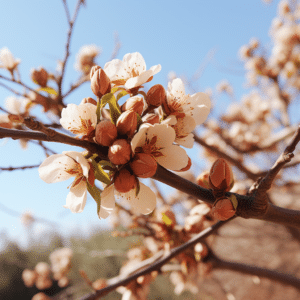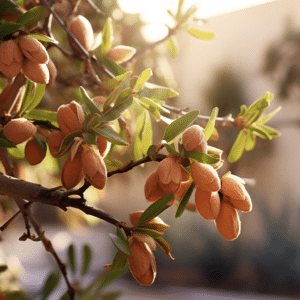Almonds are a popular and nutritious snack that can be enjoyed straight from the tree. If you’re curious about growing your own almond trees, this comprehensive guide will provide you with all the information you need to successfully cultivate and care for these delicious nuts. From understanding the biology of almond trees to protecting your crop from pests and diseases, we’ve got you covered.
Understanding Almond Trees

The Biology of an Almond Tree
Almond trees, scientifically known as Prunus dulcis, belong to the Rosaceae family. They are deciduous trees that can reach up to 30 feet in height and have a spreading canopy. The tree’s foliage consists of elongated, lance-shaped leaves that are serrated at the edges. In early spring, before the leaves emerge, beautiful blossoms appear. These blossoms are a sight to behold, with delicate pink or white petals, attracting bees and other pollinators.
Once the flowers are pollinated, they develop into fruits known as drupes. Almond drupes are oval in shape and covered by a tough, outer hull. Inside the hull, you’ll find the precious almond nut, enclosed in a hard, woody shell. Each almond tree can produce varying yields, depending on factors such as age, variety, and growing conditions.
Almond trees are fascinating not only for their beautiful appearance but also for their intricate biology. These trees have a unique way of reproducing, relying on the assistance of pollinators like bees. The delicate petals of the almond blossoms attract bees with their vibrant colors and sweet fragrance. As the bees collect nectar from the flowers, they inadvertently transfer pollen from one blossom to another, enabling fertilization to occur. This process is crucial for the development of almond drupes, which eventually house the precious almond nuts.
Furthermore, almond trees have adapted to thrive in various climates, making them a versatile and resilient species. They are known to tolerate a wide range of temperatures, from hot and dry regions to cooler, more temperate areas. This adaptability has contributed to the widespread cultivation of almond trees in different parts of the world.
Different Varieties of Almond Trees

There are several almond tree varieties to choose from, each with its own unique characteristics and flavor profile. When selecting a variety, consider factors such as climate suitability, disease resistance, and nut size. Some popular almond tree cultivars include:
- Nonpareil: Known for its sweet and delicate flavor, the Nonpareil almond is the most widely grown variety in California. It produces medium-sized nuts with a smooth, thin shell.
- Carmel: Carmel almonds are slightly larger and have a thick, hard shell. They have a strong, rich flavor and are often used for roasting.
- Mission: Mission almonds have a robust, slightly bitter flavor. They are smaller in size and have a wrinkled shell.
Each variety of almond tree offers a unique taste experience, allowing almond enthusiasts to explore a diverse range of flavors. The Nonpareil almond, with its sweet and delicate notes, is a favorite among many. Its smooth, thin shell makes it easy to crack open and enjoy the nut inside. On the other hand, the Carmel almond boasts a stronger, richer flavor, making it a preferred choice for those who enjoy a bolder taste. Lastly, the Mission almond presents a slightly bitter flavor that adds depth to culinary creations.
When it comes to selecting an almond tree variety, it’s important to consider not only the flavor but also the suitability to your specific growing conditions. Different varieties may have varying levels of disease resistance, making some more resilient in certain climates. Additionally, the size of the nuts can also play a role in your decision, as larger nuts may be preferred for certain culinary applications.
Overall, the diverse array of almond tree varieties offers something for everyone, whether you’re a fan of sweet, delicate flavors or bold, robust tastes. Exploring the different cultivars can be a delightful journey into the world of almonds, allowing you to discover your personal favorite and appreciate the nuances of each variety.
Preparing for Planting
Choosing the Right Location
Almond trees thrive in warm, Mediterranean climates, where they can receive full sun exposure. Select a location with well-draining soil and proper air circulation to avoid issues such as root rot or fungal diseases. Avoid planting in low-lying areas that are prone to frost or waterlogging.
Consider the size of the mature almond tree and plan for adequate spacing. These trees need room to grow and spread, so ensure a distance of at least 15-20 feet between each tree. This will allow for proper sunlight penetration and airflow.
Soil Requirements for Almond Trees
Almond trees prefer deep, well-draining soils with a slightly acidic to neutral pH range of 6.0-7.5. Conduct a soil test to assess the nutrient levels and pH of your soil. If necessary, make amendments by adding organic matter, such as compost or well-rotted manure, to improve soil structure and fertility. Avoid soils that are excessively sandy or heavy clay.
The Planting Process

When to Plant Almond Trees
Almond trees are typically planted in late winter or early spring when the soil is workable and the risk of frost has passed. This allows the trees to establish their root systems before the growing season begins. It’s important to ensure the availability of adequate water for irrigation during the early stages of tree growth.
Step-by-Step Planting Guide
1. Dig a hole that is wide and deep enough to accommodate the almond tree’s root system. The hole should be approximately twice the size of the root ball.2. Remove the tree from its container, gently loosen any tangled roots, and place it in the center of the hole. Ensure that the tree is positioned at the same depth it was previously planted.3. Backfill the hole with a mixture of the excavated soil and organic matter, firming it gently around the roots.4. Create a circular basin around the tree to capture irrigation water.5. Water the newly planted tree thoroughly to settle the soil and eliminate air pockets.6. Apply a layer of organic mulch around the base of the tree to conserve moisture and suppress weed growth.
Caring for Your Almond Trees
Watering and Fertilizing Techniques
Proper watering and fertilization are essential for the health and productivity of almond trees. Young trees require regular, deep watering to encourage deep root development. As the trees mature, reduce the frequency of watering but increase the volume to penetrate deeper into the soil.
Fertilize almond trees annually in late winter or early spring, just before the bud break. Apply a balanced fertilizer formulated for fruit trees. Follow the manufacturer’s instructions for the appropriate dosage based on tree age and size. Mulching around the tree with organic matter can also provide additional nutrients as it decomposes.
Pruning and Training Almond Trees
Pruning helps shape the tree, remove dead or diseased wood, and improve air circulation within the canopy. Perform annual pruning during the dormant season, which is typically in late winter or early spring. Focus on removing any crossing or rubbing branches, as well as any suckers emerging from the base of the tree.
Training young almond trees is crucial to develop strong frameworks. Use appropriate trellis systems or stake the trees to guide their growth. Prune lateral branches to promote an open center shape, allowing sunlight to penetrate evenly.
Protecting Your Almond Trees
Common Pests and Diseases
Almond trees can face various pests and diseases that can significantly impact their health and productivity. Some common pests include aphids, mites, and codling moths. Diseases such as fungal infections, bacterial canker, and peach leaf curl can also affect almond trees.
Preventive Measures and Treatments
Implementing preventive measures can help minimize the risk of pests and diseases. Regularly inspect your trees for signs of infestation or infection. Prune and remove affected branches immediately to prevent further spread. Monitor insect populations and apply appropriate organic or chemical treatments when necessary, following the instructions provided by experts or local agricultural extension services.
Additionally, promote tree health by providing adequate nutrition, proper watering, and good airflow. Mulching around the base of the tree can also help prevent weed competition and improve soil moisture retention.
By following these comprehensive guidelines for growing almonds, you’ll be well on your way to cultivating healthy, productive almond trees. Whether you’re an avid gardener or simply enjoy the satisfaction of harvesting your own crop, growing almonds can be a rewarding experience. Get started today, and soon you’ll be enjoying the fruits of your labor straight from the tree!